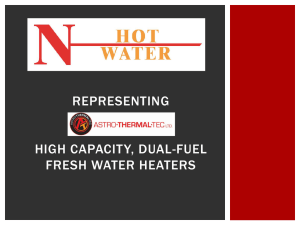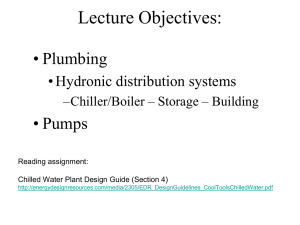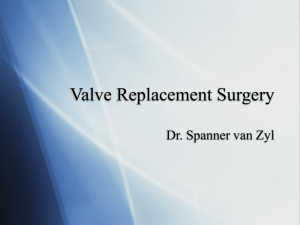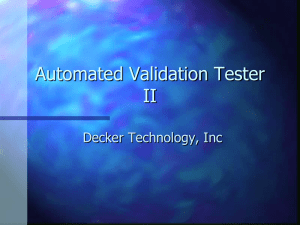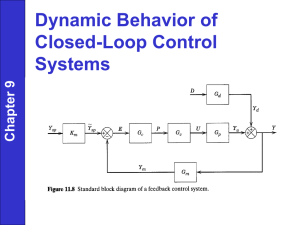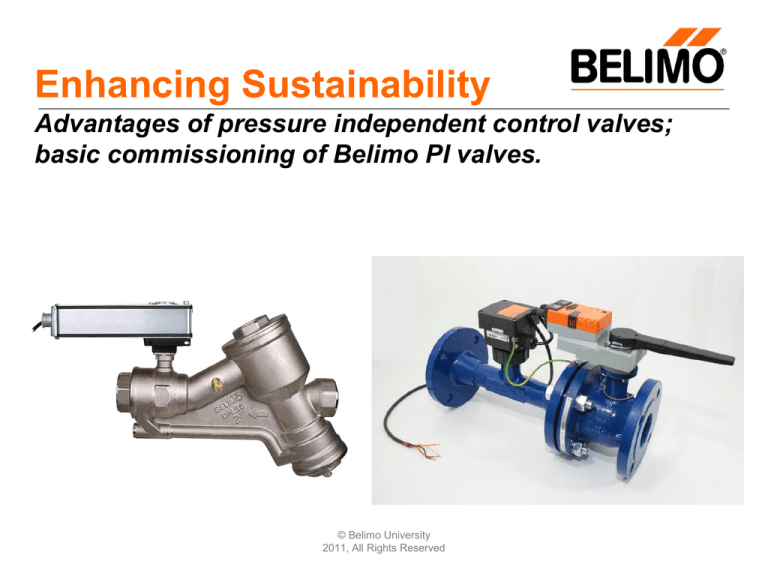
Enhancing Sustainability
Advantages of pressure independent control valves;
basic commissioning of Belimo PI valves.
© Belimo University
2011, All Rights Reserved
Enhancing Sustainability
First, an analogy between air systems and
hydronic systems.
Why are there no more VAV pressure
dependent air systems?
Enhancing Sustainability
Pressure Dependent VVT System
Air Handling Unit
Supply
Duct
How many Pressure Dependent VVT
systems have you seen lately?
Return Duct
Bypass
Duct
Balancing Damper
VVT Boxes
Space
Temp
Enhancing Sustainability
Pressure Dependent VVT System
Air Handling Unit
Part Load Performance:
•Unable to respond to flow variation
due
Supply to changing pressure conditions.
Return Duct
Duct
•Unstable
control – system is
Bypass
Duct
“oversized”.
•Occupant comfort and energy
Balancing Damper
efficiency are compromised.
VVT Boxes
•Spaces too cold (or hot).
Space
Temp
Enhancing Sustainability
Pressure Independent VAV Box
Air Flow
Temp. Control
Air Flow
Measurement Device
Controller
Controller
Part Load Performance:
Pressure Independent Control Valve
From Temp. Control
•Flow is controlled under all pressure conditions.
•Stable control – system is “rightsized”. Water Flow
Measurement
Device
•Occupant comfort and energy efficiency
are
improved.
Water Flow
•Spaces at or near design.
Pressure Independent Control Valve
What is a pressure independent control valve?
A PI Control Valve….
Is a 2-way control valve that supplies a precise flow at any given
control signal…
Regardless of pressure variations in a system.
It is not just a control valve and flow limiting circuit setter in the same
assembly!
Note:
Automatic or manual balance valves should NOT be used with PI
valves. If they are already installed they should be set WIDE
OPEN.
Pressure Dependent Control Valve
Flow rate through equal % globe valve as a function of
differential pressure (Cv = 1.9).
Pressure Independent Control Valve
Flow rate through PI Control Valve as a function of differential
pressure (3 GPM valve plotted). Equal % characteristic.
Equal % Valve Characteristic
100
Resulting
Energy
Output of
Coil
Coil Energy Output (%)
Energy
Characteristic of
Coil
90
80
70
60
50
Flow
Characteristic of
Equal % Control
Valve
40
30
20
10
0
10
20
30
40
50
60
70
80
90
100
Signal (%)
ASHRAE 2008 HVAC Systems and Equipment Handbook pg. 46.8
Advantages
•Iowa Energy Center Pressure Independent Valves Study
•Chilled Water Closed Loop Test
PICCV
Valve Water
Flow
SAT Setpoint
Change
Globe Valve Water Flow
The Pressure Dependent Valve loses authority
at part load. In effect, it becomes “Oversized”
Advantages
Energy saving potential
Globe Valve
PI Control Valve
Advantages
Energy saving potential
Totalized Flow over 24 Hrs
Globe Valve = 358.7 gallons
PI Control Valve = 283.6 gallons
Note: The over-flow and under-flow cycling of this control valve results in a net over-flow condition!
Advantages
Energy saving potential
Pump Affinity Laws
Globe Valve
PI Control Valve
HP = Horse Power
GPM = Flow in Gallons/Minute
HP1 GPM 1
HP2 GPM 2
3
3
HP 1 358.7
2.02
HP 2 283.6
Globe = 358.7 gallons
PI Control Valve = 283.6 gallons
A 26.5% increase in flow results in twice the horsepower requirements
from the pump.
Pressure Differential Sensor
Setpoint = 10 psid
Design: 400 Ton /
800 GPM CHW
System @ 12˚ΔT
Coil #4
0 - 200 gpm
2 psid
10ft H2O (4 psid)
10 psid
4 psid
Coil #3
0 - 200 gpm
12 psid
10ft H2O (4 psid)
20 psid
4 psid
Coil #2
0 - 200 gpm
22 psid
10ft H2O (4 psid)
30 psid
4 psid
Coil #1
0 - 200 gpm
32 psid
10ft H2O (4 psid)
Chiller
VFD-Pump
200 tons
Chiller
VFD-Pump
200 tons
Pressure
Dependent Control
Valves
40 psid
4 psid
Advantages
Energy saving potential
Tons 24
GPM
T
Tons 24
800 GPM
12T
800 GPM Tons 2
800 GPM
Tons
2
Tons 400
For a given load, flow and ΔT are inversely
proportionate. As flow increases, ΔT drops.
Pressure Differential Sensor
Design: 400 Ton
CHW System @
12˚ΔT
Coil #4
0 - 200 gpm
Coil #3
0 - 200 gpm
Coil #2
0 - 200 gpm
Coil #1
0 - 200 gpm
Chiller
VFD-Pump
200 tons
Chiller
VFD-Pump
200 tons
Pressure
Dependent Control
Valves
Advantages
180 Ton Load
(45%)
Design: 400 Ton
CHW System @
12˚ΔT
Coil #4
0 - 200 gpm
•Hold the load
constant and vary
the flow.
Pressure
Dependent Control
Valves
Coil #3
0 - 200 gpm
Coil #2
0 - 200 gpm
Coil #1
0 - 200 gpm
42˚
CHWS
360 GPM Loop Flow
54˚
CHWR
(12˚ΔT)
Advantages
Design: 400 Ton
CHW System @
12˚ΔT
Pressure
Dependent Control
Valves
180 Ton Load
(45%)
Coil #4
0 - 200 gpm
Coil #3
0 - 200 gpm
Coil #2
0 - 200 gpm
Coil #1
0 - 200 gpm
42˚
CHWS
52.9˚
CHWR
396 GPM Loop Flow (+10%)
(10.9˚ΔT)
Advantages
Design: 400 Ton
CHW System @
12˚ΔT
Pressure
Dependent Control
Valves
180 Ton Load
(45%)
Coil #4
0 - 200 gpm
An increase in flow
results in:
Coil #3
0 - 200 gpm
•Lower return
temperature.
•Reduced ΔT.
Coil #2
0 - 200 gpm
•Increased pumping
power.
Coil #1
0 - 200 gpm
42˚
CHWS
52.4˚
CHWR
414 GPM Loop Flow (+15%)
(10.4˚ΔT)
Design: 400 Ton
CHW System @
12˚ΔT
Pressure Differential Sensor
Coil #4
0 - 200 gpm
Pressure
Dependent Control
Valves
Coil #3
0 - 200 gpm
Coil #2
0 - 200 gpm
Coil #1
0 - 200 gpm
With a 10% overflow
ΔT Reduction goes
From 12°F (Design)
To 10.9°F (Actual)
A reduction of 9%.
Chiller
200 tons
Chiller
200 tons
With a 15% overflow
ΔT Reduction goes
From 12°F (Design)
To 10.4°F (Actual)
A reduction of 13%.
Advantages
Design: 400 Ton
CHW System @
12˚ΔT
Pressure
Dependent Control
Valves
180 Ton Load
(45%)
360 GPM Loop Flow
CHWR
CHWS
54˚
42˚
(12˚ΔT)
Chiller
200 tons
VFD-Pump
Arbitrary Value
KW=1.0k
90% Load
Chiller
VFD-Pump
200 tons
•Hold the load constant and vary the flow.
Advantages
Pressure
Dependent Control
Valves
180 Ton Load
(45%)
396 GPM Loop Flow (+10%)
CHWR
CHWS
52.9˚ (10.9˚ΔT)
42˚
Chiller
VFD-Pump
200 tons
KW=1.33k 90% Load
(396GPM/360GPM)3 =
1.33 (33% increase in
pump power!)
Chiller
VFD-Pump
200 tons
An increase in flow results in:
•Lower return temperature.
•Reduced ΔT.
•Increased pumping power.
Advantages
Design: 400 Ton
CHW System @
12˚ΔT
180 Ton Load
(45%)
414 GPM Loop Flow (+15%)
Pressure
Dependent Control
Valves
CHWR
CHWS
52.4˚ (10.4˚ΔT)
42˚
Chiller
200 tons
VFD-Pump
(414GPM/360GPM)3 =
1.52 (52% increase in
pump power!)
KW=0.76k 45% Load
Chiller
200 tons
VFD-Pump
KW=0.76k
An additional pump
and chiller were started
to meet the flow
demand, not cooling
demand!
45% Load
Also, a chiller receiving cold return water can’t load up!
Belimo PI Valves
Two Solutions for Today’s Hydronic Systems
PICCV
ePIV
½” – 2”
2 ½” – 6”
0.5 GPM – 100 GPM
105 GPM – 713 GPM
Belimo Pressure Independent Valves
Commissioning
PICCV
ePIV
(Equal %)
(Equal % or Linear; factory or field selectable)
Belimo PI Valves
PICCV
Water passes
through regulator
Pressure is P2
(intermediate)
Water exits valve
Pressure is P3 (low)
Water enters
valve
Pressure is
P1 (high)
Ports sense
pressure drop and
transfer it below
regulator
Low pressure pulls regulator
down, against the spring
force
PICCV Process Flow
Diagram
Non-Spring Return
Spring Return
DDC Controls
Valve Position Feedback
(2-10 vdc (default)/vdc
Variable)
AI
AO
AO
AI
Control Signal (2-10 vdc
(default)/vdc Variable)
Min/Max
actuator
stroke %
programming
per
application
design flow.
Note: Selection is made
with PC Tool and ZTHGEN/ZTH-PICCV.
Belimo MFT
Actuator
PICCV
Valve Stem
and Coupler
Internal
Mechanical ΔP
Regulator
P3
Equal %
Characterized Ball
Valve
P2
Process Piping
Process Piping
Note: Shown for functional
purposes only. Ancilliary
piping, mechanical
regulator and ball valve
are machined into
common valve body.
Belimo ePIV
•Magnetic Flow Sensor
•Flow Feedback and
•Control Signal
•Smart Actuator
•LGCCV Valve
Magnetic Flow Sensor
• Measures changes to the induced
voltage of a conductive fluid through a
controlled magnetic field.
• No moving parts or openings to clog
or jam.
• No maintenance.
Actuator/Flow Tolerances
Controller starts to control if delta "flow actual value" and "flow set value" > 5% (50% of the Flow
tolerance)
Controller stops to control if delta "flow actual value" and "flow set value" < 1% (10% of the Flow tolerance)
Flow Accuracy +/- 6% of Vnom
Example
Control Signal Y = 100GPM (stable no changes)
If the measured Flow is higher then 105GPM Actuator will correct until measured Flow is 101GPM.
If the measured Flow is lower then 95GPM Actuator will correct until measured Flow is 99GPM.
ePIV Process Flow/
Logic Diagram
DDC Controls
Flow Feedback (2-10 vdc
(default)/vdc Variable)
AI
AO
AO
AI
ePIV
Control Signal (2-10 vdc
(default)/vdc Variable)
Signal
Conditioning
(Linear or
Equal %
Scaling)
Selectable
Flow Feedback
Note: Selection is made
with PC Tool v3.5 and
higher and ZTH-GEN.
(Release code required)
Flow Setpoint
Internal Control Algorithm
(PV=Input from Flow Sensor)
Velocity to
Flow
Conversion
(SP=Flow Setpoint from DDC)
(PV)
(CV)
(CV=Output to Actuator for
Valve Positioning)
(FB=Flow Feedback to DDC)
Actuator (Integral
to ePIV Controller)
Closed Loop Control
4-20 milliamp
Valve Stem
and Coupler
Magnetic Flow
Sensor (External
to ePIV Controller)
Process Piping
LG-CCV
Process Piping
Installation Considerations
• 5 straight pipe diameters before the flow sensor
• no straight pipe requirement on the outlet of the valve
STRAIGHT INLET LENGTHS
•2-1/2” ePIV = 12.5”
4” ePIV = 20”
•3” ePIV = 15”
5” ePIV = 25
6” ePIV = 30”
Installation Considerations
Actuator must be kept above horizontal!
Introducing – the ePIV
electronic Pressure Independent Valve
•
Cost effective flow sensor technology combined with Belimo’s industry
leading intelligent actuators and proven characterized valve technology
•
Both non-spring and electronic fail-safe proportional models
•
Provides all the benefits of PI valves (accurate flow control, improved
efficiency at part load by reduced pumping power, improved waterside
ΔT)
•
Reduced cost, less weight, less raw materials, more sustainable!
•
True flow measurement, available to DDC system through feedback wire
•
Glycol concentration up 50% has no effect on flow measurement
•
Can be configured for either linear or equal percentage flow
characteristic with a simple program change.
Belimo Field
Programming Tool
Field adjustable programming tool
allows:
•PICCV
•Control/feedback signal
ZTH-GEN
•Custom flows/adjust flows
•Many other parameter
adjustments
• ePIV
•Control/feedback signal
•Custom flows/bias adjustment
•Flow coefficient
No external power needed; no battery; powered
by actuator 24 vac! Just plug it into actuator.
•Equal % or linear setting
•Many other parameter
adjustments
Belimo PC Tool
ePIV adjustments (PC Tool v3.5 and above)
•
Control/Feedback Signal
Voltage
– 2-10 VDC
– 0-10 VDC
– User selected
•
Flow Characteristic*
– Equal Percentage
– Linear
•
Maximum (Design) Flow
•
Bias Adjustment
Commissioning
Additional P/T PORT for verification of 5 psi (11.5
ft H20) minimum differential across the PI Valve.
Minimum ΔP across valve must be verified with PI valve
COMMANDED by DDC (or by programming tool) to design
flow, not manually positioned!
Commissioning
Step 1: Ensure all strainers are clean and bypass valves are closed.
Step 2: Command via DDC all PI valves to design flow. (Diversity
assumed at 100%.)
Step 3: Set distribution pump(s) to elevated speed by commanding
ΔP setpoint or pump speed directly.
Step 4: Find the “critical zone” (ie. the PI valve that has the least ΔP).
Step 5: Increase or decrease pump speed/ΔP setpoint until critical
zone has just over 5 psid (11.5 ft H20). The resulting ΔP at the system
sensor will be the optimum system ΔP setpoint.
Step 6: Verify total system flow is at design at main flow station (or by other
method).
Step 7: If flow is not within +/- 10% of design, start checking valves at terminal level,
starting with largest valve(s) first (voltage, control signal, strainer, etc.)
Commissioning
• Belimo PI valves do NOT require that the entire
system be placed in full design flow. Each PI
valve flow can be verified individually with the
rest of the system under normal control.
1) Command valve assembly to design.
2) Verify at least 5 psid across PI valve
assembly.
3) Verify coil flow as per usual method (coil ΔP
method, etc.)
Link for PI valve commissioning document:
www.piccv.com/pdf/PICCV_Application_Bulletin.pdf
Questions?

